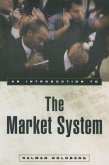J. Richardson
An Introduction to the Study of Industrial Relations
J. Richardson
An Introduction to the Study of Industrial Relations
- Gebundenes Buch
- Merkliste
- Auf die Merkliste
- Bewerten Bewerten
- Teilen
- Produkt teilen
- Produkterinnerung
- Produkterinnerung
This book gives a comprehensive survey of the field of Industrial Relations, focusing on general principles and problems. Illustrations are drawn from the practices adopted in many parts of the world such as Australia, France, Germany and the USA. Contents include chapters on the following: Personnel Management Training Methods of Wage Payment Job Evaluation Profit-Sharing and Co-partnership Trade Unionism Employers' Organizations Collective Bargaining Wage Bases Equal Opportunities Conciliation and Arbitration
Andere Kunden interessierten sich auch für
![Industrial Relations to Human Resources and Beyond Industrial Relations to Human Resources and Beyond]() Bruce E. KaufmanIndustrial Relations to Human Resources and Beyond251,99 €
Bruce E. KaufmanIndustrial Relations to Human Resources and Beyond251,99 €![French Industrial Relations in the New World Economy French Industrial Relations in the New World Economy]() Nick ParsonsFrench Industrial Relations in the New World Economy225,99 €
Nick ParsonsFrench Industrial Relations in the New World Economy225,99 €![A Guide to Sources of Information on the National Labor Relations Board A Guide to Sources of Information on the National Labor Relations Board]() A Guide to Sources of Information on the National Labor Relations Board111,99 €
A Guide to Sources of Information on the National Labor Relations Board111,99 €![An Introduction to the Market System An Introduction to the Market System]() Kalman GoldbergAn Introduction to the Market System112,99 €
Kalman GoldbergAn Introduction to the Market System112,99 €![Governance, The State, Regulation and Industrial Relations Governance, The State, Regulation and Industrial Relations]() Ian ClarkGovernance, The State, Regulation and Industrial Relations232,99 €
Ian ClarkGovernance, The State, Regulation and Industrial Relations232,99 €![Introduction to the World Economy Introduction to the World Economy]() A J BrownIntroduction to the World Economy266,99 €
A J BrownIntroduction to the World Economy266,99 €![Introduction to the Economic History of China Introduction to the Economic History of China]() Stuart KirbyIntroduction to the Economic History of China230,99 €
Stuart KirbyIntroduction to the Economic History of China230,99 €-
-
-
This book gives a comprehensive survey of the field of Industrial Relations, focusing on general principles and problems. Illustrations are drawn from the practices adopted in many parts of the world such as Australia, France, Germany and the USA. Contents include chapters on the following: Personnel Management Training Methods of Wage Payment Job Evaluation Profit-Sharing and Co-partnership Trade Unionism Employers' Organizations Collective Bargaining Wage Bases Equal Opportunities Conciliation and Arbitration
Produktdetails
- Produktdetails
- Verlag: Routledge
- Seitenzahl: 446
- Erscheinungstermin: 5. Juni 2003
- Englisch
- Abmessung: 222mm x 145mm x 27mm
- Gewicht: 689g
- ISBN-13: 9780415313841
- ISBN-10: 0415313848
- Artikelnr.: 22039802
- Herstellerkennzeichnung
- Libri GmbH
- Europaallee 1
- 36244 Bad Hersfeld
- gpsr@libri.de
- Verlag: Routledge
- Seitenzahl: 446
- Erscheinungstermin: 5. Juni 2003
- Englisch
- Abmessung: 222mm x 145mm x 27mm
- Gewicht: 689g
- ISBN-13: 9780415313841
- ISBN-10: 0415313848
- Artikelnr.: 22039802
- Herstellerkennzeichnung
- Libri GmbH
- Europaallee 1
- 36244 Bad Hersfeld
- gpsr@libri.de
Dr J Richardson
1. IntroductionThe Problem of Industrial RelationsObjects and Scope of
StudyPART 1 2. Personnel ManagementGeneral PurposeTypes of
OrganizationScopeQualities of Personnel Officers3. Selection4.
TrainingMotion StudyTraining for Management5. Time StudiesThe Bedaux System
of Work Measurement6. Methods of Wage PaymentTime RatesPiece RatesBonus
Systems7. Job Evaluation, Merit Rating, and Non-Wage IncentivesNon-Wage
Incentives8. Profit-Sharing and Co-PartnershipTypes of
SchemeDevelopmentTrade Union AttitudesValue as an Incentive9. Joint
Consultation at the WorkplacePurposes and Subjects of ConsultationPower of
Joint Councils and CommitteesRepresentation of Management and WorkplacePART
2 10. Trade UnionismFreedom of AssociationPurposes of Trade Unions11. Bases
of Trade Union OrganizationStructure and GovernmentThe Problem of the
Closed ShopTrade Union RivalriesCo-operation and Amalgamation12. The Legal
Position of Trade UnionsThe Right to StrikeThe Position of the Civil
ServantsPicketing and IntimidationBreach of ContractImmunity and Security
of Trade Union Funds13. Political Action by Trade Unions14. Employers'
OrganizationsStructureObjects and Policy15. Collective
BargainingRecognition of Trade UnionsUnfair PracticesBargaining
MachineryProvisions of AgreementsSome Legal Aspects of Collective
AgreementsIndustrial DisputesVoluntary Conciliation and ArbitrationPART 3
16. Wage Bases and PrinciplesCapacity of IndustryThe Living
WageCost-of-Living Sliding ScalesSelling-Price Sliding Scales17. Relative
WagesWage differences between IndustriesWage differences between Skilled
and Unskilled WorkpeopleRelative Wages of Men and WomenWage Differences
between Localities18. Equal Pay for Equal Work19. Family Allowances20.
Hours of WorkPART 4 21. Purposes and Scope of Intervention22. Intervention
in Wage RegulationThe Fair Wages ClauseIntervention in Private
IndustryMachinery for RegulationCriteria for Fixing Rates23. Problems of a
National Wages PolicyFactors tending towards National StandardsSome
Elements of a PolicyPossibilities and Limitations24. Conciliation and
ArbitrationConciliationVoluntary ArbitrationCompulsory ArbitrationCourts of
EnquiryMembership of Arbitration TribunalsThe Common RuleEnforcement of
Binding AwardsEffects of Trade Union Unions and Employers' Organizations25.
Relations in Nationalized Industries26. Social SecurityOrigin and
DevelopmentThe Problem of RiskFinancial Aspects, Contributions and
BenefitsPART 5 27. International AspectsKinds and Functions of
International OrganizationsThe International Labour OrganizationConclusions
StudyPART 1 2. Personnel ManagementGeneral PurposeTypes of
OrganizationScopeQualities of Personnel Officers3. Selection4.
TrainingMotion StudyTraining for Management5. Time StudiesThe Bedaux System
of Work Measurement6. Methods of Wage PaymentTime RatesPiece RatesBonus
Systems7. Job Evaluation, Merit Rating, and Non-Wage IncentivesNon-Wage
Incentives8. Profit-Sharing and Co-PartnershipTypes of
SchemeDevelopmentTrade Union AttitudesValue as an Incentive9. Joint
Consultation at the WorkplacePurposes and Subjects of ConsultationPower of
Joint Councils and CommitteesRepresentation of Management and WorkplacePART
2 10. Trade UnionismFreedom of AssociationPurposes of Trade Unions11. Bases
of Trade Union OrganizationStructure and GovernmentThe Problem of the
Closed ShopTrade Union RivalriesCo-operation and Amalgamation12. The Legal
Position of Trade UnionsThe Right to StrikeThe Position of the Civil
ServantsPicketing and IntimidationBreach of ContractImmunity and Security
of Trade Union Funds13. Political Action by Trade Unions14. Employers'
OrganizationsStructureObjects and Policy15. Collective
BargainingRecognition of Trade UnionsUnfair PracticesBargaining
MachineryProvisions of AgreementsSome Legal Aspects of Collective
AgreementsIndustrial DisputesVoluntary Conciliation and ArbitrationPART 3
16. Wage Bases and PrinciplesCapacity of IndustryThe Living
WageCost-of-Living Sliding ScalesSelling-Price Sliding Scales17. Relative
WagesWage differences between IndustriesWage differences between Skilled
and Unskilled WorkpeopleRelative Wages of Men and WomenWage Differences
between Localities18. Equal Pay for Equal Work19. Family Allowances20.
Hours of WorkPART 4 21. Purposes and Scope of Intervention22. Intervention
in Wage RegulationThe Fair Wages ClauseIntervention in Private
IndustryMachinery for RegulationCriteria for Fixing Rates23. Problems of a
National Wages PolicyFactors tending towards National StandardsSome
Elements of a PolicyPossibilities and Limitations24. Conciliation and
ArbitrationConciliationVoluntary ArbitrationCompulsory ArbitrationCourts of
EnquiryMembership of Arbitration TribunalsThe Common RuleEnforcement of
Binding AwardsEffects of Trade Union Unions and Employers' Organizations25.
Relations in Nationalized Industries26. Social SecurityOrigin and
DevelopmentThe Problem of RiskFinancial Aspects, Contributions and
BenefitsPART 5 27. International AspectsKinds and Functions of
International OrganizationsThe International Labour OrganizationConclusions
1. IntroductionThe Problem of Industrial RelationsObjects and Scope of
StudyPART 1 2. Personnel ManagementGeneral PurposeTypes of
OrganizationScopeQualities of Personnel Officers3. Selection4.
TrainingMotion StudyTraining for Management5. Time StudiesThe Bedaux System
of Work Measurement6. Methods of Wage PaymentTime RatesPiece RatesBonus
Systems7. Job Evaluation, Merit Rating, and Non-Wage IncentivesNon-Wage
Incentives8. Profit-Sharing and Co-PartnershipTypes of
SchemeDevelopmentTrade Union AttitudesValue as an Incentive9. Joint
Consultation at the WorkplacePurposes and Subjects of ConsultationPower of
Joint Councils and CommitteesRepresentation of Management and WorkplacePART
2 10. Trade UnionismFreedom of AssociationPurposes of Trade Unions11. Bases
of Trade Union OrganizationStructure and GovernmentThe Problem of the
Closed ShopTrade Union RivalriesCo-operation and Amalgamation12. The Legal
Position of Trade UnionsThe Right to StrikeThe Position of the Civil
ServantsPicketing and IntimidationBreach of ContractImmunity and Security
of Trade Union Funds13. Political Action by Trade Unions14. Employers'
OrganizationsStructureObjects and Policy15. Collective
BargainingRecognition of Trade UnionsUnfair PracticesBargaining
MachineryProvisions of AgreementsSome Legal Aspects of Collective
AgreementsIndustrial DisputesVoluntary Conciliation and ArbitrationPART 3
16. Wage Bases and PrinciplesCapacity of IndustryThe Living
WageCost-of-Living Sliding ScalesSelling-Price Sliding Scales17. Relative
WagesWage differences between IndustriesWage differences between Skilled
and Unskilled WorkpeopleRelative Wages of Men and WomenWage Differences
between Localities18. Equal Pay for Equal Work19. Family Allowances20.
Hours of WorkPART 4 21. Purposes and Scope of Intervention22. Intervention
in Wage RegulationThe Fair Wages ClauseIntervention in Private
IndustryMachinery for RegulationCriteria for Fixing Rates23. Problems of a
National Wages PolicyFactors tending towards National StandardsSome
Elements of a PolicyPossibilities and Limitations24. Conciliation and
ArbitrationConciliationVoluntary ArbitrationCompulsory ArbitrationCourts of
EnquiryMembership of Arbitration TribunalsThe Common RuleEnforcement of
Binding AwardsEffects of Trade Union Unions and Employers' Organizations25.
Relations in Nationalized Industries26. Social SecurityOrigin and
DevelopmentThe Problem of RiskFinancial Aspects, Contributions and
BenefitsPART 5 27. International AspectsKinds and Functions of
International OrganizationsThe International Labour OrganizationConclusions
StudyPART 1 2. Personnel ManagementGeneral PurposeTypes of
OrganizationScopeQualities of Personnel Officers3. Selection4.
TrainingMotion StudyTraining for Management5. Time StudiesThe Bedaux System
of Work Measurement6. Methods of Wage PaymentTime RatesPiece RatesBonus
Systems7. Job Evaluation, Merit Rating, and Non-Wage IncentivesNon-Wage
Incentives8. Profit-Sharing and Co-PartnershipTypes of
SchemeDevelopmentTrade Union AttitudesValue as an Incentive9. Joint
Consultation at the WorkplacePurposes and Subjects of ConsultationPower of
Joint Councils and CommitteesRepresentation of Management and WorkplacePART
2 10. Trade UnionismFreedom of AssociationPurposes of Trade Unions11. Bases
of Trade Union OrganizationStructure and GovernmentThe Problem of the
Closed ShopTrade Union RivalriesCo-operation and Amalgamation12. The Legal
Position of Trade UnionsThe Right to StrikeThe Position of the Civil
ServantsPicketing and IntimidationBreach of ContractImmunity and Security
of Trade Union Funds13. Political Action by Trade Unions14. Employers'
OrganizationsStructureObjects and Policy15. Collective
BargainingRecognition of Trade UnionsUnfair PracticesBargaining
MachineryProvisions of AgreementsSome Legal Aspects of Collective
AgreementsIndustrial DisputesVoluntary Conciliation and ArbitrationPART 3
16. Wage Bases and PrinciplesCapacity of IndustryThe Living
WageCost-of-Living Sliding ScalesSelling-Price Sliding Scales17. Relative
WagesWage differences between IndustriesWage differences between Skilled
and Unskilled WorkpeopleRelative Wages of Men and WomenWage Differences
between Localities18. Equal Pay for Equal Work19. Family Allowances20.
Hours of WorkPART 4 21. Purposes and Scope of Intervention22. Intervention
in Wage RegulationThe Fair Wages ClauseIntervention in Private
IndustryMachinery for RegulationCriteria for Fixing Rates23. Problems of a
National Wages PolicyFactors tending towards National StandardsSome
Elements of a PolicyPossibilities and Limitations24. Conciliation and
ArbitrationConciliationVoluntary ArbitrationCompulsory ArbitrationCourts of
EnquiryMembership of Arbitration TribunalsThe Common RuleEnforcement of
Binding AwardsEffects of Trade Union Unions and Employers' Organizations25.
Relations in Nationalized Industries26. Social SecurityOrigin and
DevelopmentThe Problem of RiskFinancial Aspects, Contributions and
BenefitsPART 5 27. International AspectsKinds and Functions of
International OrganizationsThe International Labour OrganizationConclusions








